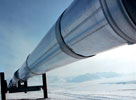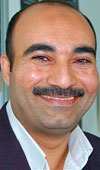

SAI&C was invited to meet with corrosion specialist Ayman Mehdawe, from Honeywell Process Solutions’ Middle East operation in Abu Dhabi, UAE, on his recent visit to South Africa. Mehdawe shared some insights into the space where the worlds of process control and corrosion intersect.

Q. Why did Honeywell decide to tackle corrosion?
A. The company wanted to differentiate itself from other companies in the process control market, to expand its portfolio in the process control environment and at the same time create a value add for clients, several of whom had approached it for help relating to corrosion problems.
Q. Honeywell’s corrosion business received a kick-start with the acquisition of Houston-based Intercorr International in 2005. What turnover does corrosion control generate for Honeywell now?
A. We do not really operate this division of the business as revenue generator in its own right, so I would not be able to answer that directly. The corrosion offerings and expertise are strategic tools which stimulate growth in other parts of the business such as risk management, Experion Process Knowledge Systems and field instrumentation devices. We continue to put a lot of effort into research and development and also have important consulting and service elements.
Excluding sales engineers we have a head count of about 45 experts operating from Houston and Phoenix in the USA, Canada, the Middle East, Africa and India.
Q. When your experts and analysts are involved in a project, do they monitor conditions remotely or is this more hands-on at the client site?
A. We prefer to work on site, where communications are more effective and we can improve operators' and engineers' understanding of the electrochemistry of the corrosion process.
Q. How do the Honeywell corrosion monitoring solutions differ from traditional approaches to this problem?
A. Traditional solutions were very process dependent. For instance corrosion in pipelines can be monitored using smart pigs and corrosion tags, and in process plant tags can also give a general indication of levels of corrosion. But at best these traditional methods help to determine general levels of corrosion. They do not help to identify the specific conditions under which corrosion peaks or drops. Using Honeywell’s SmartCET transmitters users can identify such peaks and troughs and correlate them with specific sets of process conditions. It is this time domain knowledge which is the key to maximising plant economic life from a corrosion perspective.
Q. Realtime corrosion monitoring offers the promise of operators being able to adjust processes to reduce corrosion. But are the operators able to understand the implications of their actions? For instance in one of your BASF case studies it was found that increasing the feed rate of the corrosion inhibitor actually increased the rate of corrosion.
A. The important point is that operators, process engineers and corrosion engineers can all see what is happening in realtime. Where the understanding of the chemistry is poor Honeywell can extend its support through corrosion consulting services. It is important that operators are trained to understand both the process chemistry and corrosion mechanisms at work so that they can take appropriate action.
Q. Have there been any studies or estimates done on the cost of corrosion in process plant?
A. There was a major study undertaken in the USA a while back. That study found that the overall cost of corrosion was more than US$270bn or 3% of the country’s GDP at the time.
Q. What industries and processes are at greatest financial risk from the negative effects of corrosion?
A. I would say that the industries which have a high probability of a corrosion triggered event with very high potential costs would be in the fields of oil and gas production, transmission and refining. The pipeline failures in Alaska in 2006 cost BP millions of dollars in lost production and in environmental fines. At a less dramatic level there are certain processes, such as reactor effluent air coolers in refinery hydro-processing units that are commonly susceptible to corrosion.
The problem of corrosion in refining processes has been exacerbated by high oil prices, high levels of demand and lack of capacity which are pushing owners to run plant at well past original design capacity.
Q. Are liquids pipelines more susceptible to corrosion than gas pipelines?
A. Not really. In general, the more upsets in a pipeline, the more risk there is of corrosion. This means that multiproduct pipelines need more careful monitoring than single product lines. Condensation points can be potentially problematic in gas lines.
Q. If users can monitor corrosion and more closely control the corrosive environment can they then use more cost-effective materials in their vessels and pipelines?
A. Yes, this is an important benefit of monitoring corrosion in realtime and modelling the effects of corrosion based on these measurements. Alloy steels do not have to be the materials of choice.
In fact we were recently able to help a company which had an interesting situation. The company operated two ostensibly identical plants. In the one plant, levels of corrosion were in line with design expectations. The other plant was experiencing accelerated corrosion and they spent more than one year trying to identify the cause. They had got to the point where they had budgeted US$500 000 to replace materials with more expensive alloys to combat the corrosion when they called in Honeywell. Using the SmartCET transmitters we were able to correlate peaks in corrosion levels with certain process operations and also identify a faulty valve. By repairing the valve and making changes to the process the client avoided the planned US$500 000 expenditure.
Q. Your literature mentions four real-time corrosion measurement outputs that the SmartCET transmitters can provide. Could you explain these for our readers?
A. Different measurements provide different insights into the nature of corrosion activity that is present. We use a combination of measurement techniques including electrical resistance (ER), linear polarisation resistance (LPR), electrochemical noise (ECN), harmonic distortion analysis (HAD). Using these we are able to output up to four variables to provide an indication of general corrosion level, localised corrosion (pitting), the Stern-Geary (B-value) and a corrosion mechanism indicator.
Q. One of the ways that Honeywell focuses its R&D, builds products and ultimately develops markets is through its Joint Industry Programs (JIPs). Are there any plans to bring South African companies into any of Honeywell’s corrosion JIPs?
A. The company has successfully worked with some South African companies, like Sasol, on other JIPs and we are always on the lookout for JIP projects and sponsors to further industry knowledge and process capabilities.
NACE International describes corrosion as a naturally occurring phenomenon commonly defined as the deterioration of a substance (usually a metal) or its properties because of a reaction with its environment. (www.nace.org)
For more information contact Debbie Rae, Honeywell Southern Africa, +27 (0)11 695 8000, [email protected], www.honeywell.co.za

© Technews Publishing (Pty) Ltd | All Rights Reserved